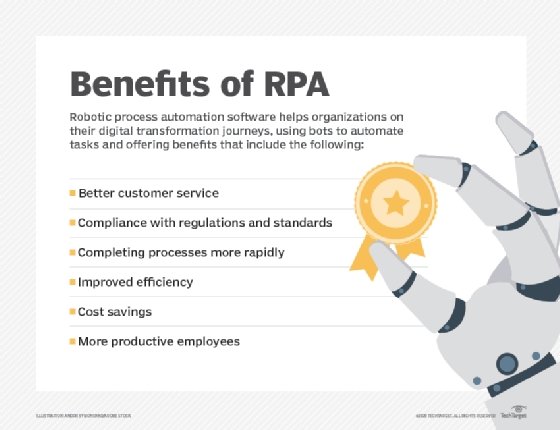
Channel partners explore RPA for MSP, client use cases
MSPs can tap robotic process automation for a multitude of applications, but they must consider the challenges of change management and multi-vendor environments.
Robotic process automation, much like the broader automation field, has taken hold since the beginning of the pandemic, when most organizations shifted to remote and hybrid workforces.
The technology continues to flourish -- global RPA software revenue is projected to reach $2.9 billion in 2022, an increase of 19.5% from 2021, according to Gartner. The market research firm said organizations will increase their RPA spending to automate repetitive, manual tasks and free up employees to pursue more strategic work.
The technology's adoption has become commonplace: Seventy-four percent of respondents to a Deloitte survey said they are already implementing RPA, according to the consulting firm's June 2022 automation with intelligence report. Intelligent automation technologies such as RPA and optical character recognition "have finally hit the mainstream," the Deloitte study noted.
RPA has also arrived in the channel partner sector. Managed service providers (MSPs) tap RPA to boost their own productivity, while also helping their customers automate key processes. But they must navigate the challenges of managing multi-vendor environments and addressing change management.
How MSPs use RPA
There are lots of use cases for MSPs to use RPA to automate IT business processes, said Gina Schaefer, intelligent automation practice leader at Deloitte Consulting.
 Gina Schaefer
Gina Schaefer
Agent assistance, with RPA supporting live call center agents, is one example of an application that became popular in the early days of the pandemic, Schaefer said. Here, RPA tools collect data and information, helping agents respond to questions more quickly.
In addition, RPA is a good augmenter for automating help desk ticket categorization and proactive server monitoring, Schaefer said. She also pointed to RPA's role in boosting service providers' responsiveness to clients.
"The classic complaint that businesspeople have with their with their IT service provider, whether in-house or external, is 'You're not responsive; you're not fast enough. You put up my opportunities in the pipeline, and I sort of wait,'" Schaefer said. RPA, however, provides a relatively low-cost way to improve a service provider's turnaround time.
Employee or customer onboarding is another area where RPA can be useful to MSPs, crossing many technology silos. The disparate nature of an organization's applications "doesn't matter to [the RPA tool] because it acts like a person" as it fills out forms in ERP or CRM systems and sends out notifications, she said.
Telus International, an IT services provider based in Vancouver, B.C., has deployed over 150 RPA processes for clients in areas including onboarding, procurement, invoicing, revenue recognition and time sheets, according to Jim Radzicki, CTO at Telus International.
"The technical capability of RPA is absolutely there," Radzicki said.

Benefits of RPA
Speed ranks among the top benefits of RPA, according to industry executives.
"RPA will do exactly what you tell it to, and it will do it at the speed of a machine versus the speed of a human," Schaefer said. "That's a classic benefit of RPA."
 James Matcher
James Matcher
James Matcher, intelligent automation leader at EY Americas, cited velocity -- the time it takes to resolve a customer's issue -- among the four primary drivers for RPA. The other three are higher productivity, the ability to de-risk a process via human error reduction and ROI through labor costs savings.
The Deloitte report also pointed to productivity and cost reduction as RPA advantages. Organizations the consulting firm surveyed said they expect intelligent automation to provide an average cost savings of 31% over the next three years.
RPA tools also offer low implementation costs because much of the work is done via drag-and-drop and low-code technology, Schaefer noted. As a result, organizations can shorten development cycles. "You can produce an impactful solution with this tooling in less than a month that might otherwise require two [to] three months for a custom-coded solution."
RPA challenges
MSPs face a number of challenges with RPA, one of which is working with customers who use multiple automation offerings.
 Jim Radzicki
Jim Radzicki
"There's very few tools that will actually bring together disparate RPA products to give you a single pane of glass," Radzicki said. "If you're only specializing in one [tool], you may run into clients with four systems."
Such multi-vendor settings become an issue for MSPs lacking a way to consolidate various automation platforms. "There are many RPA providers that claim to have dashboards … but often for only the RPAs built on their platform -- not disparate tools."
Another obstacle: Developers may not consider RPA tools "the sexiest" because the technology is off-the-shelf, fairly straightforward to implement and lacks creativity, Schaefer said. "That sort of perception might challenge the adoption internally … [but] that can certainly be overcome," she said.
MSPs must also overcome the potential for resistance from users. Adoption of RPA is predicated on "a fair amount of change management and the ability to identify where to deploy it," as well as getting humans to interact with the system to ensure it is adopted and sustained, Matcher said.
EY has found that certain sectors are more predisposed to automation, making RPA adoption accelerate more quickly, he said. Some vertical markets tend to lag, however. Adoption rates have been low in advanced manufacturing, for example, especially when it comes to deploying RPA on production lines, he noted.
In the manufacturing sector, RPA is only happening in the back office, Matcher said.
In addition to change management issues, MSPs must also consider how to sustain RPA and keep systems operational when they don't have direct control over a customer's environment, Matcher said.
MSPs should also make sure they are clear on how they will extract value from an RPA system. "Don't automate for automation's sake," he said.







